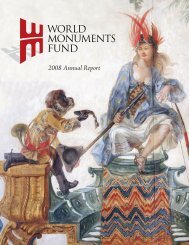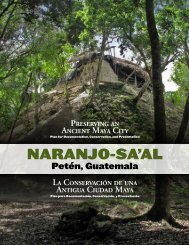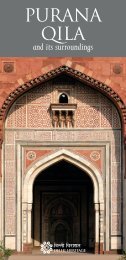Summary of the Proceedings and Papers Presented at - World ...
Summary of the Proceedings and Papers Presented at - World ...
Summary of the Proceedings and Papers Presented at - World ...
You also want an ePaper? Increase the reach of your titles
YUMPU automatically turns print PDFs into web optimized ePapers that Google loves.
The Ministry for Educ<strong>at</strong>ion, University <strong>and</strong> Research<br />
(MIUR), <strong>and</strong> <strong>the</strong> European Union alloc<strong>at</strong>ed special<br />
funds to ENEA, <strong>the</strong> Italian N<strong>at</strong>ional Agency for<br />
New Technologies, Energy <strong>and</strong> <strong>the</strong> Environment, to<br />
conduct a research project on architectural ro<strong>of</strong>ing for <strong>the</strong><br />
protection <strong>of</strong> archaeological sites. The Central Institute for<br />
Restor<strong>at</strong>ion (ICR) was also an important participant in <strong>the</strong><br />
project, responsible for <strong>the</strong> methodological prepar<strong>at</strong>ion <strong>of</strong><br />
<strong>the</strong> research). The project gave us <strong>the</strong> opportunity to implement<br />
a relevant experimental intervention on Arianna’s Villa<br />
in Castellamare di Stabia.<br />
The main objective <strong>of</strong> <strong>the</strong> project is to st<strong>and</strong>ardize <strong>the</strong> designing<br />
process <strong>and</strong> <strong>of</strong>fer methodological support to designers<br />
<strong>of</strong> ro<strong>of</strong>s on archaeological sites. We defined guidelines<br />
to design <strong>and</strong> build protective ro<strong>of</strong>s, starting from a recognition<br />
<strong>of</strong> <strong>the</strong> major factors th<strong>at</strong> contribute to deterior<strong>at</strong>ion<br />
(namely chemical, physical <strong>and</strong> biological), <strong>and</strong> through scientific<br />
activities according to <strong>the</strong> methodology <strong>of</strong> <strong>the</strong> Carta<br />
del Rischio (Risk Map) <strong>of</strong> <strong>the</strong> Italian cultural heritage.<br />
The design <strong>and</strong> realiz<strong>at</strong>ion <strong>of</strong> two protective ro<strong>of</strong>s over<br />
<strong>the</strong> archaeological sites <strong>of</strong> Arianna’s Villa <strong>and</strong> Vivara have<br />
been chosen as examples <strong>of</strong> <strong>the</strong> methodological process<br />
th<strong>at</strong> was defined through our research. The module to protect<br />
one section <strong>of</strong> Arianna’s Villa has already been realized;<br />
<strong>the</strong> ro<strong>of</strong> for <strong>the</strong> archaeological site in Vivara has been designed<br />
but not yet built.<br />
The case <strong>of</strong> Arianna’s Villa, where all <strong>the</strong> phases <strong>of</strong> <strong>the</strong><br />
project have been completed, could be considered <strong>the</strong><br />
most significant example, both because <strong>of</strong> its monumental<br />
fe<strong>at</strong>ures (outst<strong>and</strong>ing wall <strong>and</strong> pavement decor<strong>at</strong>ions) <strong>and</strong><br />
italiano<br />
Conserving archaeological areas:<br />
<strong>the</strong> study case <strong>of</strong> Ariannaís villa in<br />
Castellamare di Stabia in <strong>the</strong> framework<br />
<strong>of</strong> a research program on protecting<br />
shelters for archaeological sites<br />
by M.C. Laurenti, A. Altieri, M. Bartolini, C. Cacace, G. Fazio, E.<br />
Giani, A. Giovagnoli, M.P. Nugari, S. Ricci, C. Prosperi Porta, M. Citterio<br />
because <strong>of</strong> <strong>the</strong> wide range <strong>of</strong> protective ro<strong>of</strong>s types th<strong>at</strong><br />
have been built here, st<strong>and</strong>ing witness to various periods<br />
<strong>and</strong> styles in terms <strong>of</strong> aes<strong>the</strong>tics <strong>and</strong> <strong>the</strong> efficacy <strong>of</strong> <strong>the</strong> conserv<strong>at</strong>ion<br />
solutions employed.<br />
The designing process thus took advantage <strong>of</strong> <strong>the</strong> results<br />
<strong>of</strong> <strong>the</strong> research activity. We assessed protective ro<strong>of</strong> systems<br />
in various archaeological sites to reflect on <strong>the</strong>oretical<br />
issues about <strong>the</strong> efficiency <strong>and</strong> adequacy <strong>of</strong> protective<br />
ro<strong>of</strong>s, <strong>and</strong> conducted field analyses including <strong>the</strong> monitoring<br />
<strong>of</strong> microclim<strong>at</strong>es in <strong>the</strong> interiors <strong>and</strong> <strong>the</strong> quality <strong>of</strong> <strong>the</strong> air<br />
(from a chemical <strong>and</strong> biological point <strong>of</strong> view). Samples <strong>of</strong><br />
m<strong>at</strong>erials th<strong>at</strong> are most <strong>at</strong> risk have been also taken <strong>and</strong> analyzed<br />
(e.g. plaster <strong>and</strong> stone). The experimental applic<strong>at</strong>ion<br />
<strong>of</strong> an ad hoc 3D modeling s<strong>of</strong>tware provided by ENEA has<br />
been very useful in our research.<br />
The sector <strong>of</strong> <strong>the</strong> Villa which has been studied for a new<br />
design includes some rooms <strong>at</strong> <strong>the</strong> eastern portico <strong>of</strong> <strong>the</strong> big<br />
peristyle. They have been recently excav<strong>at</strong>ed <strong>and</strong> immedi<strong>at</strong>ely<br />
protected using a metal ro<strong>of</strong> supported by metal scaffoldings.<br />
These rooms are characterized by <strong>the</strong> existence <strong>of</strong><br />
much-deterior<strong>at</strong>ed painted plaster, typical <strong>of</strong> <strong>the</strong> so-called<br />
IV style. Before installing <strong>the</strong> new ro<strong>of</strong>, we executed <strong>the</strong><br />
most urgent conserv<strong>at</strong>ion interventions, <strong>and</strong> put into place<br />
provisional measures to physically protect structures <strong>and</strong><br />
decor<strong>at</strong>ions.<br />
Our research has shown th<strong>at</strong> protective ro<strong>of</strong>s can contribute<br />
gre<strong>at</strong>ly to <strong>the</strong> conserv<strong>at</strong>ion <strong>of</strong> archaeological sites, but<br />
cannot fully guarantee protection if o<strong>the</strong>r conserv<strong>at</strong>ion measures<br />
are not also put into effect. Often, as in <strong>the</strong> case <strong>of</strong> Arianna’s<br />
Villa, environmental interventions are also necessary.
















